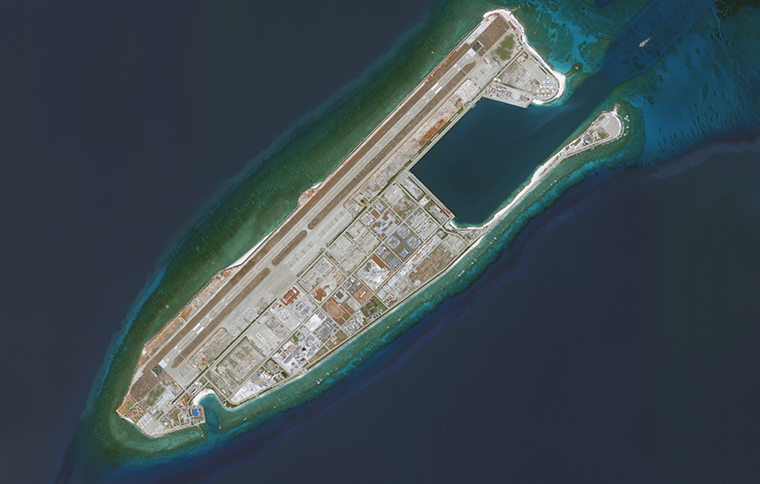Analyses / Asia-Pacific
4 June 2024
Preventing the People’s Republic of China from Prevailing in the Grey Zone: The United States’ New Imperative in the South China Sea

“There are two ways to fight the American military – asymmetrically and stupidly,”[1] is how U.S. General H.R. McMaster presents the choice facing any actor seeking to oppose the United States. Unsurprisingly, the People’s Republic of China (PRC) has opted for asymmetry in order to secure de facto control over a large number of atolls, islands and reefs in the South China Sea and their surrounding waters, while rendering any serious reaction—whether by affected littoral states or by Washington—virtually impossible. It is thus clear that the substantial territorial gains achieved by the PRC in the South China Sea, and the day-to-day assertion of sovereignty over the waters Beijing claims as its own, have not been made possible by the powerful frontline vessels of the People’s Liberation Army Navy (PLAN). Rather, Beijing relies on what James R. Holmes calls “Small Stick Diplomacy”—the deployment of the People’s Armed Forces Maritime Militia (PAFMM) and the China Coast Guard (CCG), using vessels of much lower capability and tonnage than those of the PLAN, but ideally suited to harassment missions[2], ISR (intelligence, surveillance and reconnaissance), and persistent presence. It is these forces that are on the front line and engage daily with the fishermen and coast guards of South China Sea littoral states that oppose Beijing’s claims.
To achieve its aims, the PRC deliberately operates in what Nadia Schadlow terms “the space between peace and war.” The PAFMM and CCG do not hesitate to use tactics falling under the category of non-lethal force, such as the intentional ramming of third-country vessels and the use of high-pressure water cannons to flood engines and destroy navigation equipment. These actions are clearly not peaceful, yet they do not qualify the situation in the South China Sea as an armed conflict either. They belong instead to a new form of conflict: the grey zone.
The Grey Zone: A New Form of Conflic
There is currently no universally accepted definition of the grey zone, and the difficulty of formulating one will be addressed later. Nevertheless, the most concise is that proposed by Michael Mazarr, who characterises a grey zone conflict through the following four markers[3]:
- The conflict pursues political objectives through coordinated campaigns.
- It is dominated by non-military and non-kinetic means.
- Actors involved strive to remain below escalation thresholds and avoid crossing red lines in order to prevent open conventional conflict.
- Objectives are achieved gradually rather than through decisive outcomes in a fixed timeframe.
However, it would be misleading to reduce PRC grey zone actions to their kinetic dimensions. The vast majority of these operations are presence missions carried out by second-tier PAFMM and CCG units, as well as by vessels from China’s fishing fleet, across the key maritime points claimed by Beijing. Moreover, the study of grey zone campaigns cannot be limited to the maritime dimension alone. It is crucial to grasp the scope of what China refers to as the “Three Warfares.” This concept encompasses psychological warfare (border military manoeuvres, cultural or economic diplomacy, etc.), aimed at reducing the cost-benefit ratio of a forceful response in the eyes of the target state and pushing it towards inaction. It is coupled with media warfare, designed to create ambiguity around the statements of opponents of grey zone campaigns. In this respect, the hybrid nature of the PAFMM—both a civilian and military organisation—is especially well-suited: “By putting on military uniforms, [PAFMM members] become soldiers; by taking them off, they become [mere] civilians.” The final element of the triptych is legal warfare, through which the PRC constantly seeks to lend de facto control over the South China Sea a veneer of legal legitimacy, relying on historical claims or selective legal interpretations—the best-known example being the “nine-dash line” and the so-called creation of historic rights to justify its territorial assertions.
It is also essential to understand the gradual nature of China’s grey zone campaigns and the centrality of escalation control. As Peter A. Dutton writes: “Rather than adding rungs to the top of the escalation ladder, [the PRC] is adding rungs to the bottom.”[4] Instead of seizing all the territory it claims in a single stroke, the PRC applies a “salami slicing” tactic, dividing the targeted spaces into small portions and gradually taking control over time. Andrew Scobell even describes this approach as “slow-intensity conflict.” Thus arises the dilemma facing the victims of China’s grey zone campaigns: “Are we willing to risk armed escalation with a regional superpower—who is also a major trading partner—without any guarantee of allied support, and all over an uninhabited atoll occupied by unarmed fishing boats with no clear links to the Chinese state and who have not used lethal force?”
PRC Grey Zone Actions and the U.S. Response Dilemma
Before devising a strategy to counter China’s actions, one of the thorniest problems must first be addressed: how should these actions be classified? As noted earlier, the grey zone is neither peace nor war—so what is it? This remains a key stumbling block for all states confronted with grey zone challenges, particularly the United States. In the current debate, one name surfaces regularly in discussions on how to conceptualise Chinese actions: David Galula, the so-called “Clausewitz of counterinsurgency.” Based on surface-level similarities between his work and Chinese tactics, some analysts label China’s approach as “maritime insurgency,” thereby logically calling for a counterinsurgency response. However, this reading is flawed and leads to major misunderstandings of Galula’s work, the most significant being that insurgency is inherently intra-state, focused on resolving an internal “problem” that motivates the insurgent, and characterised by the central use of lethal force. It quickly becomes apparent that applying a counterinsurgency logic to a state actor with conventional military superiority in the South China Sea could lead to an escalation scenario that neither the PRC nor the United States desires. Though it should be noted that most proponents of the “maritime counterinsurgency” model adopt a more measured stance and do not push their logic to extremes.
Nevertheless, the value of the American strategic debate should not be overlooked. Prominent authors such as Michael Mazarr, Hal Brands and Robert Haddick are conducting major research that, while not yet resulting in a universally accepted concept, has begun to outline the defining characteristics of grey zone conflict—clearly justifying the uniqueness of this mode of warfare and the need to devise dedicated strategic responses to the PRC.
Most telling of all, however, is the 2022 National Defense Strategy of the United States, which states that the U.S. faces “competitor doctrines that pose new threats to the U.S. homeland and strategic stability” and represent “an escalation of coercive grey zone activities.” Grey zone methods are described as “coercive approaches that may fall below the perceived threshold for U.S. military response and that affect multiple elements of the U.S. government.” Notably, the Department of Defense acknowledges that conventional military tools are not necessarily the most appropriate responses to the grey zone: “traditional military tools may not always represent the most appropriate responses.” Finally, the DoD recognises the need for a comprehensive approach to counter grey zone actors, one that includes combined operations with allies and interagency cooperation.
Assessment and Outlook for China’s Grey Zone Strategy
First and foremost, the extent of China’s gains must be put into perspective: these are de facto gains, secured through constant maritime presence in contravention of international law, and can only be maintained at the cost of sustained deployment of CCG and PAFMM forces in key grey zone theatres—without which they would be immediately lost. This raises the question of how victory in the grey zone is defined. As Mazarr writes: “For China, the day all other coastal states accept Beijing’s claims over the key elements of the South China Sea would be an obvious sign of victory. But that day will never come.” Worse still, the PRC is now facing the entry of non-littoral powers into the South China Sea alongside the Philippines. Canada, Australia, Japan, India and the United States have all announced joint patrols with Manila to counter the PRC’s grey zone campaigns—or have already conducted them. Thus, in the long term, Beijing may have lost far more than it has gained: its image in the South China Sea is severely tarnished—“the region [now] sees China as an imminent threat”[5]—and the exploitation of fishery or hydrocarbon resources in occupied areas is proving prohibitively expensive due to the constant need for protection. But among all the risks associated with the grey zone, the most dangerous of all remains the possibility that the escalation Beijing has so far managed to avoid might one day come to pass—with global consequences. To quote Mazarr once again: “In the long run, an accumulation of aggressive postures will provoke reactions, even if no major red line is ever crossed.”

